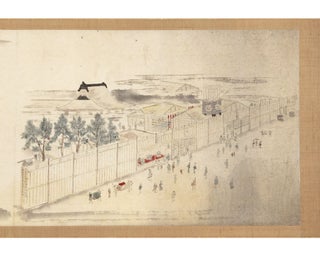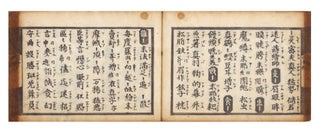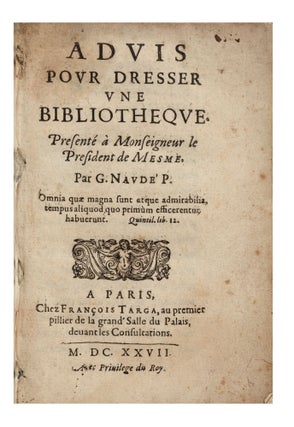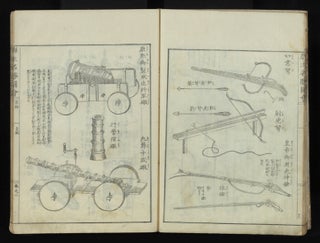A Remarkable Photograph with an Equally Remarkable Provenance
The Forty-Foot Telescope at Slough. Photographed by Sir John F.W. Herschel [photographed 9 September 1839; this print made in] August 1890.
Circular silver photographic print, 92 mm. in diameter, mounted on paper incorporating a printed title and descriptive letterpress dated August 1890 with the signatures of two of Herschel’s sons, mounted on card. Some small areas of abrasions to the paper surface. In the original frame, by Ryman & Co. of Oxford, made from the rungs of the ladder to the telescope. With a fragment of an original (?) printed descriptive notice on the back.
This is the earliest photograph of a scientific instrument and the first photograph deliberately taken to record an object prior to its disappearance (the earliest “record” photograph). It is also the earliest surviving photograph taken on glass and Sir John Herschel’s only surviving camera image.
This example is the Herschel family copy, by direct descent from Sir John F.W. Herschel through his daughter Amelia and her husband Sir Thomas Wade.
Although some images had previously been made on light-sensitive paper, this image was made in the first year of photography as we know it, i.e. using the negative/positive process. On 22 January, Herschel heard about Daguerre’s experiments. On 30 January, the second day of his photographic researches, Herschel made the first of several images of his father’s 40-foot telescope using a Dollond telescope lens. These images were the first “negatives” (as he called them), and Herschel’s only photographic subject. He fixed these images on paper with his method of using sodium thiosulphate, or “hypo,” which came to be recognized as the most useful of all the chemicals proposed as the fixer for silver-based photographic images. A few prints or “positives” were made from the negatives at the time, and none survive today. On 1st February he was visited by William Henry Fox Talbot who was shown a picture of the telescope, “freshly made.”
In the following months, Herschel began to use glass, in order to eliminate the organic substances contained in paper and for the sake of improved transparency.
The earliest surviving photograph on glass is Herschel’s image of his father’s famous 40-foot telescope at Slough, taken on 9 September 1839. By 1890, no original prints of this image were known and so 25 copies were made by projection from the best of the original negatives which had been on exhibition in the Science Museum, the photographic work being done by Sir John Herschel’s eldest son Sir William J. Herschel (1833–1917), himself a pioneer of color photography. The present copy is one of those 25, and is signed on the mount by two of Herschel’s sons including Sir William. It has been kept in the Herschel family ever since. The negative, now faded almost beyond recognition, is also preserved in the Science Museum.
The 40-foot telescope was constructed by William Herschel (1738–1822) on the grounds of his house in Slough, and completed in 1789. It was the largest of a succession of important instruments that Herschel himself made. The massive reflecting telescope weighed over a ton, and became a much-visited wonder of the age. It was the largest telescope in the world for some fifty years, and the two 4-foot mirrors made for it were also the largest in the world. By 1839 the frame was becoming unsafe so in December of that year it was dismantled, but not before William’s son Sir John Herschel had taken this image of it. The frame of this copy was made from the rungs of the ladder that went up to the telescope.
A most remarkable survival.
❧ Gernsheim, The History of Photography, pp. 95-“Herschel’s photographic researches are concentrated within the first few years after the discovery of photography, and the genius and energy which he displayed were overwhelming. For him, it would have been an easy matter to invent a photographic process earlier had he felt, like Niépce, any urge to do so, or had he believed that it would facilitate his work, as Daguerre and Talbot and Reade did. As far back as 1819 Herschel discovered the property of the hyposulphites as solvents for silver salts, whereas ignorance of this fact had proved the stumbling-block to other investigators in photography for a long time. Herschel’s scientific knowledge was indeed so great that on merely receiving a note, on 22 January 1839, from Captain (later Admiral) Beaufort telling him the bare fact of Daguerre’s discovery, ‘a variety of processes at once presented themselves,’ and only a week later Herschel succeeded in producing his first photograph.”.
Price: $25,000.00
Item ID: 6384

![Item ID: 6384 The Forty-Foot Telescope at Slough. Photographed by Sir John F.W. Herschel [photographed 9 September 1839; this print made in] August 1890. Sir John Frederick William HERSCHEL.](https://jonathanahill.cdn.bibliopolis.com/pictures/6384.jpg?width=768&height=1000&fit=bounds&auto=webp&v=1541600749)
![The Forty-Foot Telescope at Slough. Photographed by Sir John F.W. Herschel [photographed 9 September 1839; this print made in] August 1890.](https://jonathanahill.cdn.bibliopolis.com/pictures/6384_2.jpg?width=320&height=427&fit=bounds&auto=webp&v=1541600749)



